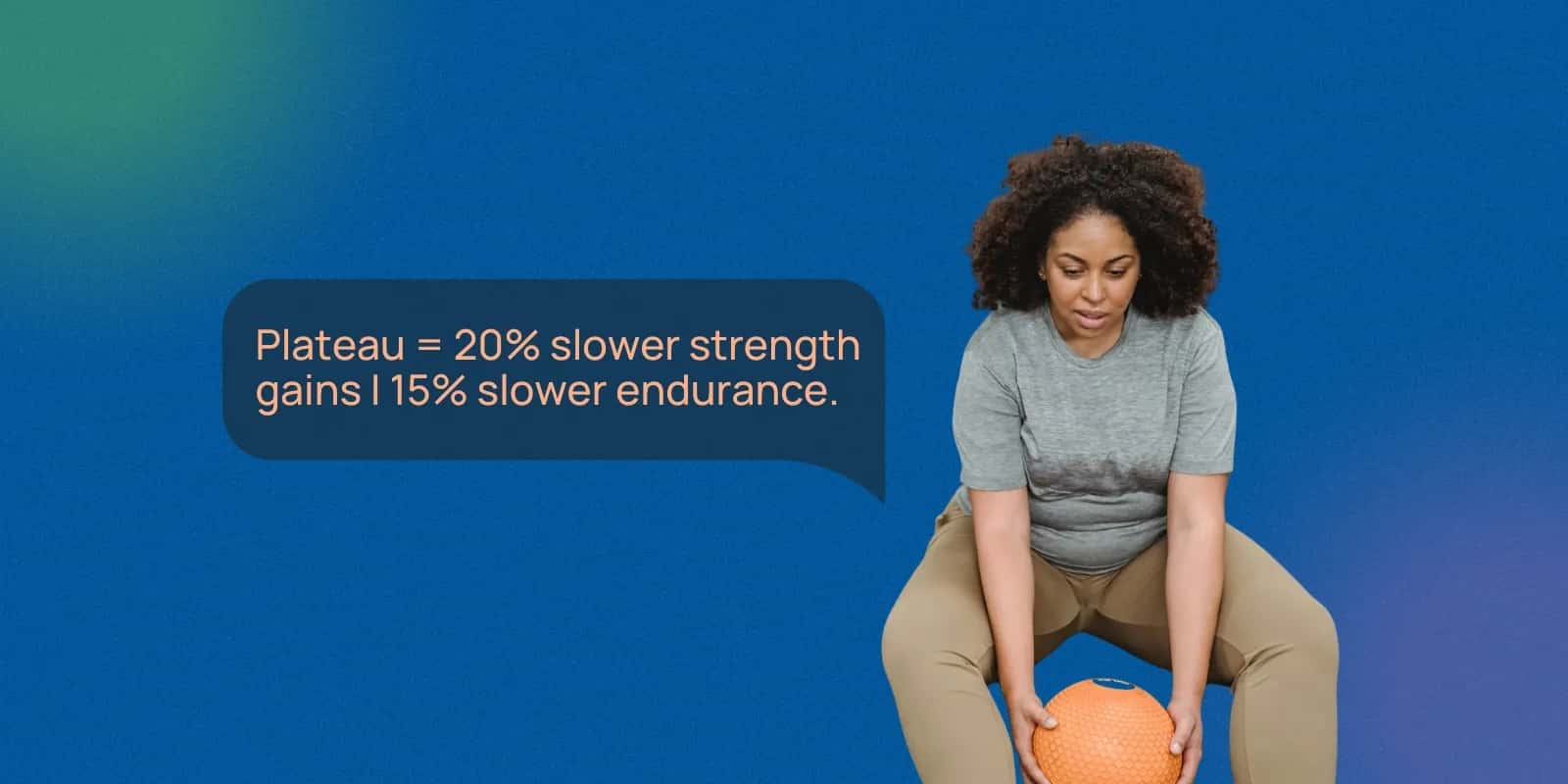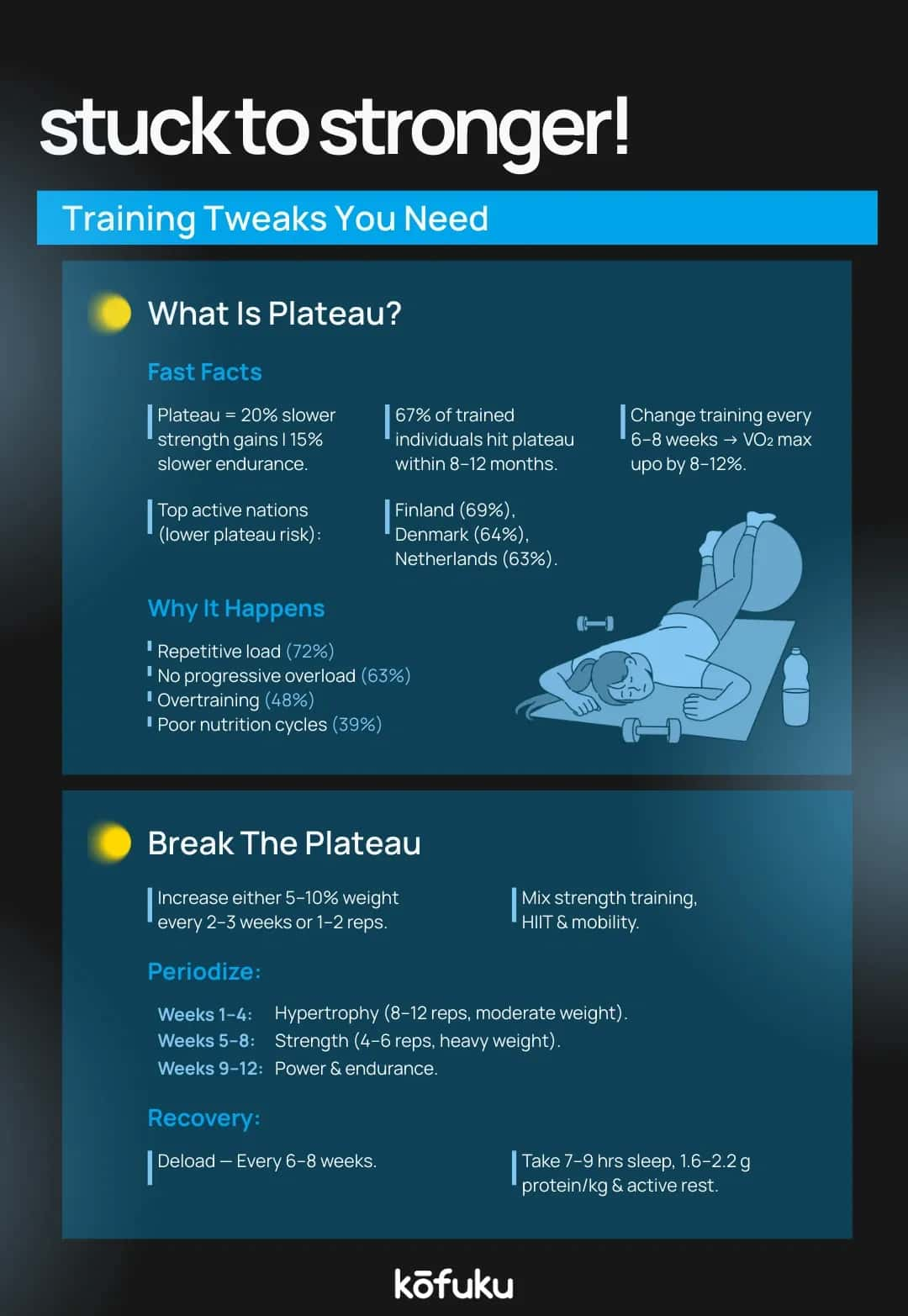Fitness for Athletic Body Type: How to Avoid the Plateau

Introduction
Everyone dreams of an athletic body, and we know you are, too! But how to get an athletic body? With so much information available on the internet, what are the ways that would work for you? Learn everything about how to get an athletic body, what an athletic body looks like and much more.
People with athletic bodies generally have an affinity towards sports, but they also face challenges in their fitness journey. One of the challenges is hitting the training plateau.
A workout plateau is a feeling of being ‘stuck’ that can stretch up to two weeks or more. During this, you don't see the growth in the weight you can lift, the reps you can complete or the intensity at which you can train.
An exercise plateau is a stage of progress where your body adapts to and adjusts to the current training, and as a result, it stops improving. But, how to get an athletic-looking body despite this? The key is to remember that having an athletic body isn't about just being strong but lean, agile and balanced too. Whether you are chasing performance or overall wellness, sticking with the same routine inevitably leads to plateaus.
This guide explores how to get a lean athletic body, what it means, what an athletic body looks like and ten strategies to break through fitness plateaus for good.

1> Set Unique and Measurable Goals
An athletic body means different things to different people: speed, power, endurance or athletics. Before getting into what an athletic body looks like, establish what matters the most to you.
-
Smart Goals: Plan smart goals as ‘I want to run five kilometres under 25 minutes’, or ‘I want to deadlift 1.5 x body weight’.
-
Define success metrics: Define your success metrics at a pace that feels comfortable to you. These can include strength numbers, body composition, times, and vertical jump height. Clear benchmarks prevent vague progress reports.
-
Frame your goals: Framing your goals around ‘how to get a lean athletic body,’ which is often reducing body fat while preserving muscle, is a hallmark of athleticism.
Setting measurable targets ensures steady progress and highlights plateaus early. That way, you can adapt before your body becomes complacent.
2> Progress Gradually
What do you think is one of the deadliest plateau traps? It's trying to overreach too fast.
- Deload cycles help reset your nervous system and help reduce fatigue.
- Incrementally raise your intensity, volume, or complexity by no more than five to ten per cent every week.
- If you are running 20 km weekly, add only 2 km per week or swap runs with interval training to build speed and endurance.
Graduation, along with consistency, aligns with how athletic body types adapt most effectively. This helps avoid overtraining and burnout, leaving your performance primed for long-term gains.
3> Learning and Unlearning
What does an athletic-looking body require beyond pushing hard?
-
Unlearn: Often, you have to unlearn things to adapt to new things. Maybe your idea of a good cardio is a long, slow run, but HIIT is what your body needs now. Only with unlearning can you rewire the patterns of your body to achieve the results you target.
-
Learn: Learn new movements and patterns, and master fundamental lifts like squats, hip hinges, and push-ups. These foster a lean, functional physique.
Building an athletic physique requires a mindset shift; don't cling to what you know. This curiosity-driven, adaptive approach prevents early plateaus.
4> Incorporate Variety
Muscles and mind thrive on novelty and so,:
-
Swap: Switch from barbell back squats to sumo or goblet variants.
-
Change: Blend resistance, plyometrics, agility drills and unilateral movements.
-
Shift: Regularly shift tempos, rest times and set structures.
Variety pushes your physical capabilities and helps rebuild the symmetrical, agile structure of an athletic body.

5> Diminishing Returns
We often tend to gain plateaus faster when expectations don't align with biology.
-
Newbie gains come fast, but elite-level improvements are slower.
-
Don't forget to track relative progress, not just raw numbers.
-
Recognise that a small time split reduction or a few extra reps can be significant at advanced levels.
This mindset will help keep the motivation alive and also reframe small gains as worthy wins.
6> Consistency
This one is non-negotiable!
-
Show up regularly, even when life demands flexibility.
-
Build daily habits that support your training cycles: adequate sleep, nutrition, and mobility work.
-
A consistent 80 per cent effort and 80 per cent adherence per month can beat short-term perfection every time.
Consistency is the engine that transforms effort into an authentic athletic body.
7> Allow for Rest and Recovery
Recovery is never optional; it's foundational!
-
Utilise nap days, foam rolling, yoga and active rest.
-
Perform low-intensity movements after intense sessions to help flush out inflammation.
-
Use sleep tracking metrics to ensure you are sleeping enough and recovering fully.
An athletic body requires frequent training and sufficient recovery, a balance essential to avoid stagnation.
8> Try a New Training Method
When the sense of being stuck or stagnant strikes, switch gears.
-
Periodisation can be helpful. For example, cycle between strength, hypertrophy and power blocks.
-
Try methods like contrast training, tempo variation, or undulating periodisation.
-
For endurance athletes, transitioning from mileage-based training to Fartlek sessions or tempo runs is beneficial.
New stimuli force the body to improve. It's one of the secrets to unlocking the next levels.
9> Get a Training Partner or Coach
A training guide or coach can help fast-track noticeable changes.
-
Accountability keeps you on your toes; missing sessions is harder when someone else tracks your efforts and expectations.
-
A coach identifies weaknesses, corrects them, and designs periodised plans tailored to your athletic goals.
-
A partner brings a sense of friendly competition that can elevate intensity and fun.
Human connection fuels consistency and elevates purpose.
10> Monitor Your Progress
The final step is to track meaningful markers to avoid emotional plateaus.
-
Use performance data, such as times, weights, angles, and explosiveness.
-
Keep a simple journal of subjective metrics, such as how you feel, perform, and recover.
-
Visually tracking body measurements, keeping posture pictures and marking athletic movement assessments are essential.
-
Reassess every four to six weeks. If the numbers don't budge, adjust your plans.
If numbers are not tracked, it doesn't influence. If you want to know how to get an athletic body, data-driven insights are your greatest tools.

FAQs
Q. What is a fitness plateau, and why does it occur?
A. A plateau is a juncture within an exercise regimen when the gains halt, and an individual experiences no advances in their fitness condition, even though they continue exerting the same energy in their course of action.
This is because the demands of the training regime become readily adapted by your body, meaning your body becomes efficient. As a result, you need to apply more stimulus to continue progressing.
Q. How can athletic body types overcome plateaus?
A. Athletic body types typically remain on course with progressive overloading, adjustments to exercise regimens, and effective recovery. This involves adding more intensity (to the training), altering the nature of the training, and good rest and nutrition.
Q. Should you change your workout routine to break a plateau?
A. Yes, changing your workout routine is often recommended to break through a fitness plateau. Regularly switching up exercises, intensity, or volume can prevent your body from adapting to the same routine, which can lead to stagnation in progress.
Q. How does diet impact fitness stagnation?
A. A poor diet can significantly hinder fitness progress, leading to stagnation. It can lead to a lack of energy, slow down muscle recovery, disrupt sleep, and even increase the risk of injury, all of which negatively impact workout performance and results.
Q. Can rest and recovery help beat a plateau?
A. Yes, rest and recovery are crucial for breaking through a fitness plateau. Overtraining can hinder progress, leading to plateaus, injuries, and burnout. Taking adequate rest days, prioritising sleep, incorporating active recovery, and focusing on nutrition are all vital components of an effective recovery strategy.

10 Recovery Techniques for Fitness Enthusiasts

8 Reasons Why Fitness Is Crucial for Heart Health

Age Is Not a Limitation for Fitness - Break Limitations

Fitness for Older Adults - Mobility and Flexibility

Discover the Benefits of Natural Fitness


